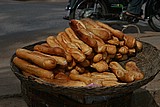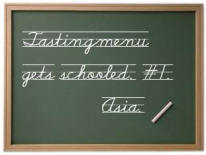Home |
Restaurants by City
|
Food Photography |
Archive | Philosophy |
![]()
Right now we are eating in Seattle, Washington.
|
Wednesday
2006
Permalink
|
Eating in Cambodia, tasted on December 6-10, 2005 — (Note: continued from yesterday's post on being in Cambodia.) There are two factors I thought of as potentially illuminating in terms of what food in Cambodia would be like. 1) They were a French colony, and 2) the water isn't safe to drink. The first raised my hopes that the French/Southeast Asian mix of food traditions would result in something wonderful. (I consider the Vietnamese sub one of nature's finest creations and it's an obvious example of this type of colonial culinary melding.) And yet, how can a country where you can't drink the water have their act together enough to offer great food in abundance? And in the end, the latter factor won out... ...sort of. My only experience eating Cambodian food in the past has been in Boston, MA at a series of Cambodian restaurants owned by the same family. And the food there us quite enjoyable. It's not Thai. Nor is it Vietnamese. It's in the general vicinity but still all its own with an emphasis (from my limited perspective) on lime juice and beef. Lots of beef. Other stuff too, but definitely more beef than I'd seen in any other Asian cuisine I was familiar with. I’m a big planner. I like to figure out all the details in advance and I do so on a regular basis, whatever the trek I’m taking – Cambodia, supermarket, whatever. So, I decided I wouldn’t plan things out for Cambodia. I suppose I’m trying to grow a little. A little. ; ) When I got to Phnom Penh I browsed the web for recommendations and I even sent mail to a fellow blogger (western) who’s living in Cambodia. Only later did I notice that every recommendation I got was for food within a 1 km radius of my hotel. My hotel is absolutely beautiful and conveniently located to the museums and the palace. The center of the tourist trade. And sure enough, every restaurant recommended to me was in that same zone. Frommer’s only recommends restaurants in the tourist area. For god’s sake, couldn’t they even find one Khmer restaurant to recommend? I should have known better, but I finally relented and decided to try the 'best French restaurant in town'. I understand that there were many deeply negative effects from the colonization of southeast Asia, but that doesn’t mean there was no upside. And the fusion of French and Asian food in Cambodia and Vietnam is definitely upside. As I mentioned, I figured, French food in Cambodia would be interesting and delicious. For the most part that's unfortunately wrong. It was more lame tourist crap. I knew I had to break out. After some cajoling, one of the hotel staff finally admitted to me that there was a big restaurant district a couple of kilometers away, but it was across the Mekong River, and I’d need one of the motorbike or tuk tuk drivers to take me there and bring me back as no tourists go there, so there are no drivers waiting around to take tourists anywhere. I knew this was the place for me. In the early evening as the sun was setting I found Ravy
the tuk tuk driver. Ten dollars round trip to Prek Leap. (Cambodia
basically operates on US currency.) We started the trek out to Prek Leap
on a series of progressively worse roads. And while the bumps were
terrible, at least I got to breathe in the pollution from the trucks
that kept veering way to close to us for my comfort. (Strangely Phnom
Penh seems less polluted to me than Bangkok did.) After we crossed the river, there were literally hundreds of restaurants lining the road. Some huge monstrosities. Some tiny little shacks with a TV where all the diners appeared to be there so they could watch the soaps, news, or sports on the TVs. After much convincing of my driver he finally took me to a middle-sized place. It was in fact a restaurant located in behind someone's home. The proprietor's were tickled that I was there, everyone giving me looks like - "Oh aren't you an odd little visitor here. Maybe you're lost." But after negotiation, and with the help of my driver I got a couple of beef dishes and some beer of course (cause I'm desperately trying to avoid drinking any water or eating anything that is uncooked). The food was ok. Better than the crappy tourist lunch I had, but not as good as Cambodian food I've had in the U.S. And slowly I figured out that this place (and many nearby) were focused mainly on providing lots of beer and prostitutes for the Cambodian men that frequented the places. My driver assured me that in fact the gaggle of girls serving me dinner were not in fact daughters of the woman who owned the place and took my order, they were in fact girls from the countryside who were there to service the various Cambodian men who came into drink and then use the girls' services. They all looked super young. Scary. I went home hoping that the next day would prove more successful. I tried one other local place. I was searching for a "crusty rice" restaurant. I never did find one. I did however end up at another restaurant where they were super amused that I was there. Two little girls (this time actual family members thank god) kept poking me in the back while I ate to try and get my attention. Eventually they were shooed away. This place was back on my side of the river but outside the tourist district near the hospital. The guide told me where to go for crusty rice, but I never did find it. The loc lac (beef dish) I got was not really cooked enough. I ate not quite enough to look like I enjoyed it but more than enough to convince myself I had contracted some sort of raw beef disease. They also gave me a pitcher (not a tall glass, but an entire pitcher) of beer. Before I left however a little kid came by and offered to sell me this little fried rice cracker in a bag. My hosts told me it was called Noumbai k’dan. It was super crunchy, savory, and delicious. Not bad for six cents. I did try hotel restaurants as well as the rules that hotel restaurants are almost always bad doesn't usually apply in Asia. The restaurant at the Amanjaya in Phnom Penh, K West Cafe, was actually not bad, especially when I ate the Khmer dishes. I avoided ordering pizza, spaghetti, or hamburgers, but the loc lac was pretty decent. However up in Angkor I stayed at the Raffles Grand Hotel D'Angkor. The hotel was gorgeous in a very colonial way. Very old, great service, and it really transported you. I felt as if I'd just completed a three month journey from England and found a small oasis of civilization where they still served tea. Aside from feeling sort of uncomfortable in this colonial make-believe, and the fact that I don't enjoy tea, it was really a very cool place. That said, they catered to a more traditional tourist crowd (read, retired Americans). The requisite buffet was not very good. The high end restaurant serving dinner was not bad though. The soup in particular was good. While Siem Reap (the Angkor region) is thriving on tourism (when I visited the region a new hotel seemed to be opening every week), the capital Phnom Penh is thriving in a different way. Despite the corruption, people are obviously trying and there's motion and economic activity everywhere. There's even some modern Khmer offerings. My hotel was one, and a restaurant owned by the same folks was another. The restaurant I went to - Malis - was beautifully designed, served modern Khmer food (according to the chef), had an open kitchen, etc. felt like a western restaurant in a good way. There were definitely some culinary highlights food was somewhat uneven, but they had only been open for a few days. If I were back in Phnom Penh I would definitely go to Malis to see how they'd evolved. There's money in Phnom Penh for a very small percentage of the population. But that percentage is growing I think. I did have a very positive food moment that involved no actual eating. We were out in the countryside when I learned that the fields we were passing were filled with rice. I realized that I didn't know what rice actually looks like. I was a little embarrassed taking pictures of the folks harvesting the rice, but it was cool to actually finally know what rice looked like as it grew. Neat. My quest was really to find authentic and fantastic local food. I failed in the latter, and unfortunately I think I may have succeeded in the former. By no means was my five days spent in Cambodia an exhaustive food exploration. But I really did try to cover many places on the spectrum (including trips to the markets). And I felt like the food I found was pretty representative of a lot of the food available to the various strata of society. And it wasn't very good. I don't know if it's the poverty, the restrictions I put on what I ate because of the water, or something else entirely. I know from experience that Cambodia food is a wonderful and unique cuisine. I just wasn't able to find any that really made me super happy. I almost hope I get comments telling me that I blew it and chose wrong at every turn. And if only I'd done X or Y I would have had wonderful food in Cambodia. At least in that case I would learn what to do next time. Anyway, even though I felt like I could have had a better food experience, don't think for a second that Cambodia isn't an incredible place. I fell in love with the country. Things are moving so fast there that I bet the food options are improving on a daily basis. I can't wait to visit again.
|
|||
Our Sponsors
Free Car Listings – Hot Tubs – Stools – Saunas – Bar Stools - Calendar and Event Schedules - Food Events and Calendars - Wine Events and Calendars - Digital Photography Resources - Software for Advertisers - Jewish Gifts and Judaica - Howard Stern Podcast - ponytailed blogger Jonathan Schwartz

Browse tastingmenu
Home |
Restaurants by City X |
Food Photography |
Archive | Philosophy |
![]()
Free eBooks: All About Apples
| Autumn Omakase
More:
Discussion |
Cool Food T-Shirts |
Ingredients
| Markets |
Recipes
Search |
Blog FAQ |
Other
Blogs
Best of tastingmenu
|
City View
Entry: July 6, 2006 |
Blue Plate
Entry: June 19, 2006 |
L'Atelier de Joël Robuchon
Entry: July 18, 2006 |
Browse by City
Boston | Chicago | Houston | Las Vegas | Los Angeles | Maui | New York | Philadelphia | Portland | San Francisco | Seattle | Toronto | Utah | Vancouver | Washington D.C.
Bangkok | Beijing | Hong Kong | Seoul | Tokyo
Amsterdam | Berlin | Italy | London | Madrid | Paris | Vienna
Browse by Month
2006
2005
2004
2003
2002
2001
Comments, questions, or feedback:
info / at / tastingmenu / dot / com
All pages Copyright (c) 2001-2006 tastingmenu.com
Last modified 01/30/07.





